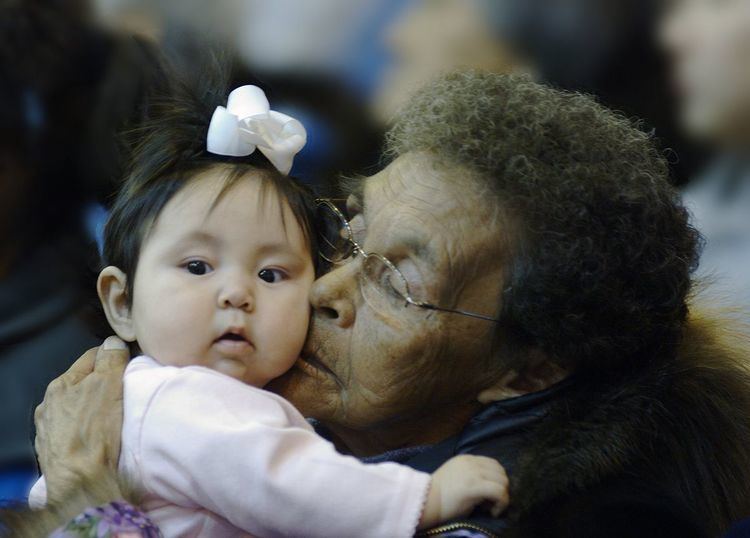 | ||
The Iñupiat (or Inupiaq) are an Alaskan Native people, whose traditional territory spans Norton Sound on the Bering Sea to the Canada–United States border. Their current communities include seven Alaskan villages in the North Slope Borough, affiliated with the Arctic Slope Regional Corporation; eleven villages in Northwest Arctic Borough; and sixteen villages affiliated with the Bering Straits Regional Corporation.
Contents
Name
Iñupiat (/iˡnuːpjɑt/ or /iˡɲuːpiæt/) formerly Inyupik, is the plural form of the name for the people, and the name of their language; Iñupiaq (/i-ˈnü-pē-äk/) is the singular form (also sometimes refers to the language), and Iñupiak (/i-ˈnü-pē-ɑːk/) is the dual form; the root words are iñuk 'person' - and -piaq 'real', i.e. the combined meaning of the self-referential is 'real people'.
Ethnic groups
The Iñupiat people are made up of the following communities,
Regional corporations
To equitably manage natural resources, Iñupiat people belong to several of the Alaskan Native Regional Corporations. These are the following.
Languages
Inupiat now speak only two native languages: North Alaskan Inupiat and Northwest Alaskan Inupiat. Many more dialects of these languages flourished prior to contact with European cultures. English is spoken by the Iñupiat because in Native American boarding schools, Iñupiaq children were punished for speaking their own languages.
Several Inupiat people developed pictographic writing systems in the early twentieth century. It is known as Alaskan Picture Writing.
The University of Alaska Fairbanks offers an online course called Beginning Inupiaq Eskimo, an introductory course to the Inupiaq language open to both speakers and non-speakers of Inupiaq.
History
Along with other Inuit groups, the Iñupiaq originate from the Thule culture. Circa 1000 B.C., they migrated from islands in the Bering Sea to what now is Alaska.
Iñupiaq groups, in common with Inuit-speaking groups, often have a name ending in "miut," which means 'a people of'. One example is the Nunamiut, a generic term for inland Iñupiaq caribou hunters. During a period of starvation and an influenza epidemic (carried to them by American and European whaling crews,) most of these people moved to the coast or other parts of Alaska between 1890 and 1910. A number of Nunamiut returned to the mountains in the 1930s.
By 1950, most Nunamiut groups, such as the Killikmiut, had coalesced in Anaktuvuk Pass, a village in north-central Alaska. Some of the Nunamiut remained nomadic until the 1950s.
The Iditarod Trail's antecedents were the native trails of the Dena'ina and Deg Hit'an Athabaskan Indians and the Inupiaq Eskimos.
Subsistence
Iñupiat people are hunter-gatherers, as are most Arctic peoples. Iñupiat people continue to rely heavily on subsistence hunting and fishing. Depending on their location, they harvest walrus, seal, whale, polar bears, caribou, and fish. Both the inland (Nunamiut) and coastal (Taġiumiut, i.e. Tikiġaġmiut) Iñupiat depend greatly on fish. Throughout the seasons when they are available food staples also include ducks, geese, rabbits, berries, roots, and shoots.
The inland Iñupiat also hunt caribou, dall sheep, grizzly bear, and moose. The coastal Iñupiat hunt walrus, seals, beluga whales, and bowhead whales. Cautiously, polar bear also is hunted.
The capture of a whale benefits each member of an Iñupiat community, as the animal is butchered and its meat and blubber is allocated according to a traditional formula. Even city-dwelling relatives, thousands of miles away, are entitled to a share of each whale killed by the hunters of their ancestral village. Maktak, which is the skin and blubber of Bowhead and other whales, is rich in vitamins A and C. The Vitamin C content of meats is destroyed by cooking, so consumption of raw meats and these vitamin-rich foods contributes to good health in a population with limited access to fruits and vegetables.
Since the 1970s, oil and other resources have been an important revenue source for the Iñupiat. The Alaska Pipeline connects the Prudhoe Bay wells with the port of Valdez in south-central Alaska. Because of the oil drilling in Alaska’s arid north, however, the traditional way of whaling is coming into conflict with one of the modern world’s most pressing demands: finding more oil.
Culture
Traditionally, different Iñupiat people lived in sedentary communities, while others were nomadic. Some villages have been occupied continuously for more than 10,000 years, such as Mary's Igloo fish camp.
The Nalukataq is a spring whaling festival among Iñupiat.
There is one Iñupiat culture-oriented institute of higher education, Iḷisaġvik College, located in Barrow.
Current issues
Iñupiat people have grown more concerned in recent years that climate change is threatening their traditional lifestyle. The warming trend in the Arctic affects their lifestyle in numerous ways, for example: thinning sea ice makes it more difficult to harvest bowhead whales, seals, walrus, and other traditional foods; warmer winters make travel more dangerous and less predictable; later-forming sea ice contributes to increased flooding and erosion along the coast, directly imperiling many coastal villages. The Inuit Circumpolar Council, a group representing indigenous peoples of the Arctic, has made the case that climate change represents a threat to their human rights.
As of the 2000 U.S. Census, the Iñupiat population in the United States numbered more than 19,000. Most of them live in Alaska.
Iñupiat territories
North Slope Borough : Anaktuvuk Pass (Anaqtuuvak, Naqsraq), Atqasuk (Atqasuk), Barrow (Utqiaġvik, Ukpiaġvik), Kaktovik (Qaagtuviġmiut), Nuiqsut (Nuiqsat), Point Hope (Tikiġaq), Point Lay (Kali), Wainwright (Ulġuniq)
Northwest Arctic Borough : Ambler (Ivisaappaat), Buckland (Nunatchiaq), Deering (Ipnatchiaq), Kiana (Katyaak, Katyaaq), Kivalina (Kivalliñiq), Kobuk (Laugviik), Kotzebue (Qikiqtaġruk), Noatak (Nuataaq ), Noorvik (Nuurvik), Selawik (Siilvik, Akuligaq ), Shungnak (Isiŋnaq, Nuurviuraq)
Nome Census Area : Brevig Mission (Sitaisaq, Sinauraq), Diomede (Inalik), Golovin (Siŋik), Koyuk (Quyuk), Nome (Siqnazuaq), Shaktoolik (Saqtuliq), Shishmaref (Qiġiqtaq), Stebbins (Tapqaq), Teller (Tala), Wales (Kiŋigin), White Mountain (Natchirsvik), Unalakleet (Uŋalaqłiq)
